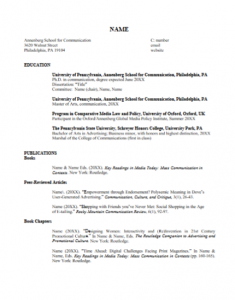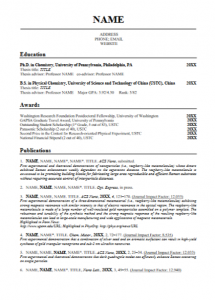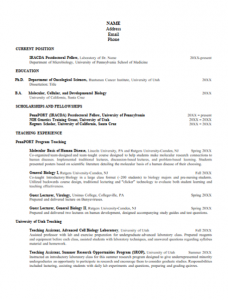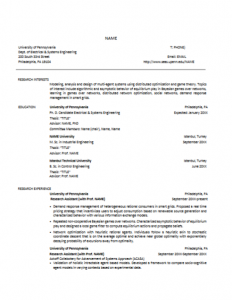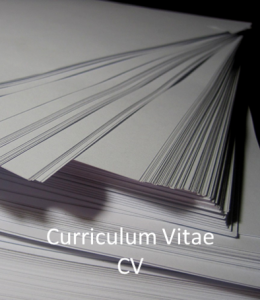The CV is a complete summary of all of your academic achievements and can be as long as needed. Although it will grow longer as your academic career progresses, you’ll want to make sure that you include accomplishments that are relevant and important. It typically includes sections such as education, publications, awards/grants/fellowships, conference presentations, teaching experience, research experience, academic/professional service, professional affiliations, and references. Depending on the institution you’re applying to, your CV will be able to answer these basic questions that search committees will ask: What is your dissertation topic? Have you published? Do you have teaching experience? Have you presented at major conferences in your discipline? What are your teaching and research interests?
The Purpose of a CV
A Curriculum Vitae (CV) details all your academic credentials and professional accomplishments and is used for seeking faculty jobs as well as for applying for academic postdoctoral research opportunities, grants and fellowships. The purpose of the CV is to interest a committee in interviewing you. Although there is basic information that should always appear in your CV, you select the “message” of accomplishments that will show you are a strong candidate for a particular job, department and institution. In ordering your CV it is important to pay attention to position’s requirements and the kind of school (e.g., research institution, liberal arts college, community college).
CVs vary slightly from discipline to discipline, so you should make sure to look at the CV’s of others in your field – fellow grad students, other postdocs in your lab, new faculty in your department – or show your CV to your advisor. Keeping in mind that different fields have different CV conventions, the advice below is meant to be a broad overview, rather than field specific. For a detailed discussion of CV structure and content as well as many sample CVs of people who obtained academic jobs or postdocs, see the Academic Job Search Handbook, available to Penn doctoral students and postdocs for $10 at Career Services.
Timeline: Getting Started with your CV
Step 1: Before drafting your CV, review all your qualifications. Using the categories suggested below, list everything which you might include. This list will form the basis for your CV and will help you identify your accomplishments. Eventually you will choose how to order your information for each application, but initially it is important not to overlook anything relevant.
Step 2: The next step is to find a job to apply to, or at least the type of job you want to apply to. To be most effective in your applications, you must understand the conventions of the field you wish to apply to and the kinds of institutions that interest you.
Step 3: Go through the job announcement and carefully note the requirements the hiring institution is seeking. Based on your research of the institution and department on their website as well as information you may have from your advisor or others, write a CV that illustrates that you have relevant qualifications and experience. In this stage, you should experiment with the format, pare down irrelevant information, have the CV critiqued by a Career Services advisor, and then make at least one more draft before you produce the final version. Have your CV looked over by many pairs of eyes, including your dissertation advisor, PI or committee members, especially for accurate proofreading, but know that everyone will have different ideas for you.
Anatomy of a CV
Every CV should include information about your education and relevant professional experience. Content suggestions are that you organize each section in reverse chronological order (listing the most recent first, and then going back in time) and put the most important information on the first few pages. Use clear, easy-to-understand language.
Standard CV Categories include: Name and contact information, education, honors and awards, experience, or more specifically “research experience” and “teaching experience,” publications and presentations, scholarly/professional affiliations, research interests and teaching competencies.
Many other sections may be added, including: professional experience, licensing/registration/certification, grants, university service, extracurricular and community activities, languages, computer and research skills, additional information, references.
Within standard and optional categories, showcase your strengths in relation to the job that interests you. If you are applying for positions in different types of institutions or departments, you will probably need more than one version of your CV. For example, you can vary them by using different headings to emphasize information of particular relevance to a position. In general, whatever is most important merits the most space.
Formatting and Layout
Layout is crucial to the impression your CV makes. In general, the simpler the formatting the easier it is to read. Use a standard font that is easy to read. Although there is no page limit, be concise. Include your name on every page, and a page number. To create emphasis, use indentations, capitalizations, spacing, or boldface. Avoid putting dates on the left-hand margin, as this emphasized when you did something rather than the experience you are trying to showcase. Use formatting techniques consistently. The following elements can be listed in a different order in your CV.
- Contact information
Your name, address, telephone and email should always come first as part of the “header” of a CV. List only phone numbers which you’re sure will be answered professionally. Make sure the voicemail message is appropriately professional. List only one email address. If you have a website, you may also list the URL in your contact information/header. - Education
Most Ph.D. candidates will want to have the education section listed as their first category, while postdocs might want to have “Current Research Experience” as a first category. In reverse chronological order, list all your degrees from your present or most recent program back to your college experience. List the name of the institution, and date degrees were awarded. List the date you expect to receive the degree for the program you are currently in, for example “Ph.D. Immunology, degree expected, May 2021”. If you are a doctoral student who will not complete your degree for some time, date the times important milestones were completed, such as completing all coursework or passing qualifying exams. You may include details in this section such as special areas of academic concentration, title of dissertation or thesis, and name of advisor. You may also list additional research projects and names of members of your dissertation committee. - Honors and Awards
These categories can be combined with “Education” or given separate sections, depending upon how significant or numerous they are. If you have received several prestigious and highly competitive awards, for example, you might want to highlight them with a separate section. Commonly known honors (Phi Beta Kappa) need no explanation, but other awards can be briefly explained. Foreign students, in particular, should stress the degree to which an unfamiliar award was competitive. For example, “One of three selected from among 2,000 graduating chemists nationally.” - Experience
In this section, more than any other, you will emphasize material in proportion to its probable interest for a particular audience of employers. For faculty positions, a common breakdown is “Teaching Experience” and “Research Experience”. Describe each experience to give an overview of what you did, with an emphasis on what you were able to accomplish in the position. If you are describing a research project, give a brief introductory statement indicating what you set out to accomplish and what results you obtained. If relevant, go on to indicate important research techniques you used. - Research Interests
This section is a brief answer to the question, “what’s next?” It must be credible and you should be prepared to elaborate on this if you get an interview. - Research Techniques/Computer Skills or Other Specialized Skills
This section is usually in the form of a simple, specific list. If you are listing laboratory research skills, include only the more specialized and difficult ones you have mastered. List the most relevant skills first. - Grants
Use this category only if you have received significant funding. Dissertation and fellowship support are usually listed in “Honors and Awards.” List the funding agency and the projects that were funded. The work supported by the grant can be discussed in detail under “Experience.” - Scholarly Memberships/Leadership
List memberships in societies in your discipline. If you have been very active in university committee work or your scholarly community, you might include that information here, or create a separate section. Moderating a panel would be a good example of something that might fit under this heading. - Additional Activities
Volunteer work with charity organizations, student groups, alumni associations, or civic or political groups can be of interest, but if you have too lengthy a section it might signal that you are not serious enough about your scholarship. Occasionally you may be concerned about reaction to disclosing political or religious activities/affiliations. In such cases, you can use more general phrases, such as “the Pennsylvania Senatorial primary,” rather than identifying a campaign by the candidate’s name. - Publications/Presentations
List publications and presentations in reverse chronological order. If you have a long list, have separate sections for publications and for presentations, and then subdivide by topics (peer reviewed papers, reviews or posters, invited talks). You can list a few articles that are in preparation and will realistically be published. - References
Having strong letters of recommendation from faculty who know your work well is crucial to a successful job search. While it is really up to you as to whether you list your references on the CV a majority of job candidates do just that. Even if you are certain your advisor and committee members will serve as references for you it is common courtesy to ask and to give them plenty of time to write letters. To list references on your CV include for each one their name, title, department, institution, mailing address, phone number and e-mail address.
CV Samples
View CV samples from different fields, provided by Penn graduates and postdocs after their successful job searches.
|
Communication PhD sample CV |
Economics PhD sample CV |
Chemistry PhD sample CV |
|
STEM postdoc sample CV |
STEM postdoc sample CV |
Engineering PhD sample CV |




